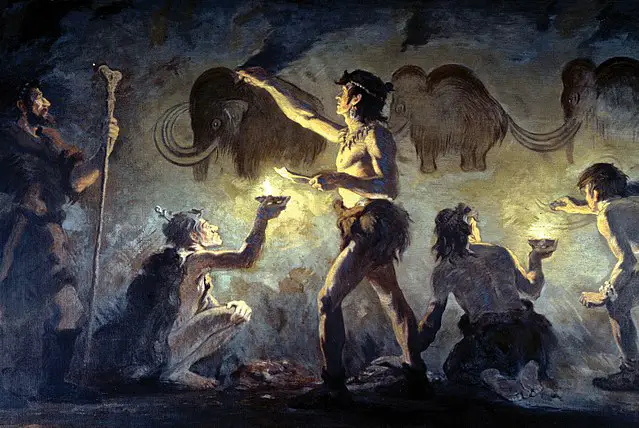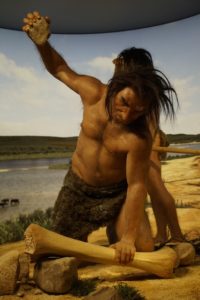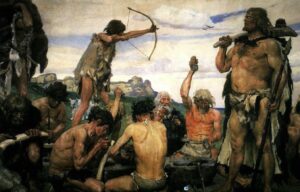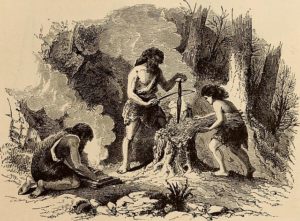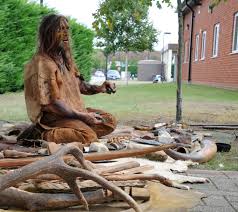The Stone Age is the beginning of human civilization and is a very interesting period to read and learn, especially for kids. Kids are often curious about the Stone Age People and their way of life. We have gathered complete information about the Stone Age People, the Stone Age Man and the Stone Age Woman. You are going to learn about their appearance, the old stone age people, the new stone age people, where they lived, their houses, their lifestyle, clothing, food, drink, hunting, stone-age tools, and many other fun facts about the stone age people.
Stone Age People
1. What Did Stone Age People Look Like
- The Stone Age was a period (started around 2.5 million years ago and ended around 2,000 BCE with the start of the Bronze Age) when people started the formation of tools from stones.
- The stone age people were shorter than the present-day people.
- The average height of a woman was about 5 feet (154 cm) and of a man was about 5.4 feet (166 cm).
- Stone-age people were well-built as compared to the present-day humans and had strong muscles on their bones.
- They also had heavier skulls and well-developed jaw muscles due to a harsh diet.
- Their average lifespan was only about 35 years.
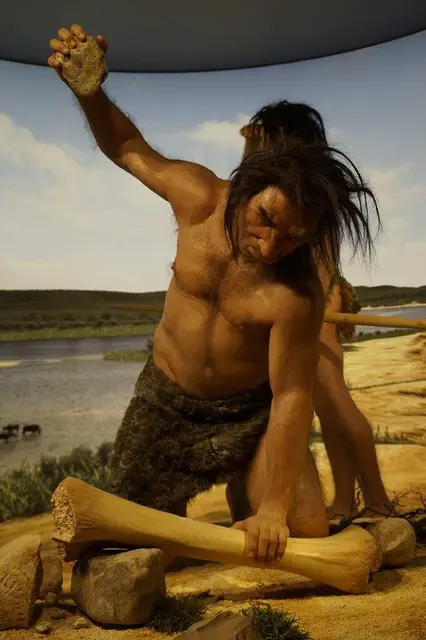
2. Old Stone Age People – Old Stone Age Man
The Stone Age Is Divided Into Three Periods:
- The Old Stone Age (the Paleolithic period) (“paleo” refers to ancient) which was from 2.5 million years ago to 10,000 BCE
- The Middle Stone Age (Mesolithic period) (“meso” refers to the middle) was from 10,000 BCE to 7,000 BCE
- The New Stone Age (the Neolithic period) (“neo” refers to new) was a period until around 2,000 BCE
- While “lithic” is a term used by archeologists to refer to the stone age.
- People of the Old Stone Age (Paleolithic period) were nomads and lived usually in small groups.
- They had not any permanent residence and moved from one place to another in the search of food and to avoid a harsh climate.
- They used a great variety of plants and animal flesh as food.
- They collected different types of herbal fruits, edible roots, mushrooms, honey, insects, many types of small animals, etc, daily for food.
- Large human groups and communities depended on the successful hunting of large-sized animals.
- That is why the thinking and life of the people of all the cultures of the old stone age (or Paleolithic period) were greatly influenced by hunting skills.
- They made stone tools mainly for hunting animals, for peeling their skin, and for cutting meat.
- At the start of the Paleolithic period, people made only spike-type tools from stones.
- However, in the Upper Paleolithic, their hunting techniques developed significantly and they began to make other tools including arches.
- Besides hunting, people of the old stone age were also involved in fishing.
- For the capturing and killing of fishes, they probably utilized harpoons made up of bones and stone hooks.
- Archeology science believes that people of the old stone age consumed food in the raw form, a form in which it naturally existed.
3. New Stone Age People – New Stone Age Man
- People of the New Stone Age period (Neolithic period) lived in small social groups or tribes of multiple lineages.
- They made new tools from stones and shaped them through grinding or polishing.
- They learned how to grow crops and developed farming skills by manufacturing a wide range of tools from stones and animal bones needed in the harvesting and processing of crops (like grinding stones and sickles).
- Farming of crops (especially cereal grains) enabled the people of the New Stone Age to built permanent accommodations due to which they abandoned nomadism and gathered in villages.
- that were the New Stone Age men who began livestock domestication.
- Freedom from the nomadic lifestyle and group-hunting allowed the people of the New Stone Age to have time for pursuing new and specialized skills.
- So that was the people of the New Stone Age who initiated weaving and the formation of pottery.
4. Stone Age Man
- Men of the Stone Age were shorter than the present-day men with an average height of 5.4 feet.
- They had stronger muscles and bones due to the hard lifestyle and greater physical activities.
- Men of the early stone age (Paleolithic period) were nomads and relayed on hunting and fishing for food.
- Their life was simple and they had only two things to do; defending themselves from wild animals and gathering food.
- They consumed food in raw and harsh form due to which they had powerful jaw muscles.
- However, men of the later Stone Age (Neolithic period) started crops cultivation, settled in small social groups, and were more skilled than the earlier Stone Age men.
5. Stone Age Woman
- Women of the Stone Age were tough mothers who shared about all the routine duties of men.
- Like Stone Age men, Stone Age women were also shorter than the present-day women with an average height of only 5 feet.
- It is estimated that the Stone Age women had about 11 to 16% more arm strength than the modern elite female athlete.
- Studies also show that Stone Age women were involved in manual labor activities along with their male partners.
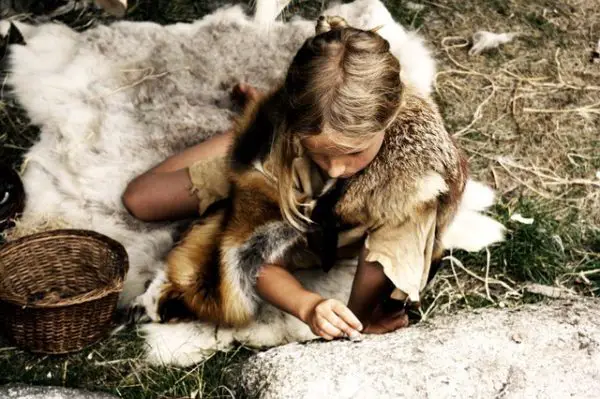
6. Where Did Stone Age People Live
- At the beginning of the Old Stone Age (Paleolithic), humans and other hominins were primarily found in East African countries (Kenya, Ethiopia, and Tanzania) and in the eastern part of the Great Rift Valley.
- Approximately 2,000,000 to 1,500,000 BP (Before Present) groups of humans and other hominids started migration from Africa and settling in Asia and Southern Europe.
- Around 1,700,000 BC, they occupied the Southern Caucasus (the Caucasus is a region located between the Black Sea and the Caspian Sea, the south part of which is roughly corresponding to present-day Georgia, Armenia, and Azerbaijan) and reached the northern part of China about 1,660,000 BP.
- At the end of the Old Stone Age (Paleolithic), humans and other hominins were also living in present-day China, western parts of Indonesia, and Europe.
- Human settlements of the New Stone Age (Neolithic) include:
- Göbeklitepe, Aşıklı Höyük, Nevalı Çori, Çatalhöyük in Turkey
- Guilá Naquitz Cave and Oaxaca in Mexico
- Tell Qaramel and Tell Zeidan in Syria
- Franchthi cave or Frankhthi cave and Sesklo in Greece
- Nanzhuangtou in Hebi, the Pengtoushan culture in Hunan, Jiahu, Lajia, and the Hemudu culture in China
- Byblos in Lebanon
- Jericho in West Bank, the Palestinian territory
- Mentesh Tepe and Kamiltepe in Azerbaijan
- Ayn Ghazal in Jordan
- Chogha Bonut, Ganj Dareh in Iran
- Jhusi and Lahuradewa in India
- Khirokitia in Cyprus
- Mehrgarh in Pakistan
- Porodin in Serbia, North Macedonia
- Padah-Lin Caves in Burma
- Petnica in Serbia
- Stara Zagora in Bulgaria
- The Cucuteni–Trypillian culture in Ukraine, Moldova, and Romania
- The Tabon Caves complex in Palawan Island, Philippine
- The Megalithic Temples in Malta
- The Knap of Howar and Skara Brae in Orkney, Scotland
- Brú na Bóinne and Lough Gur in Ireland
- The Norte Chico civilization in Peru
- The Tagant Plateau in Mauritania
7. What Did Stone Age People Live In
- People of the Old Stone Age (Paleolithic) were mainly nomads and lived in small groups in jungles and caves.
- People of the Middle Stone Age (Mesolithic period) also lived in groups. But they were not so many nomads and often resided in dome-shaped shelters made up of woods covered with animal skins.
- Their shelters were mainly of three types:
- Caves
- Hut or tepee, a wooden structure covered with animal skin or plant matter.
- Permanent dwellings
- Humans of the New Stone Age (Neolithic) were skilled farmers who settled in villages. They lived in houses built of wood, wattle, daub (a mixture of clay, mud, dung, and hey stuck), and stones. Their houses had shelves, beds, and fireplaces.

8. How Did Stone Age People Live – Stone Age Man Lifestyle
- The lifestyle of the Old Stone Age (Paleolithic) people was simple and they had two things to do; to hunt and gather food and to protect themselves from the wild animals and beasts.
- However, the lifestyle of the Middle Stone Age (Mesolithic) and New Stone Age (Neolithic) people was slightly complex.
- They had learned crops cultivation that provided them a constant food supply due to which they became socialized and permanently settled in villages.
- Other than farming, people of the New Stone Age had also discovered some special crafts like weaving and pottery.
- They invented bows and arrows and innovated their stone tools.
9. What Did Stone Age People Wear – Stone Age Man Clothing
- People of the Old Stone Age wrapped animal skins to keep themselves warm in the harshly cold climates.
- Cloths of the New Stone Age (Neolithic) people were also made up of animal skins, however, they also made clothes by weaving grasses.
- In the late Neolithic period, they had also probably wear clothes made up of wool.
10. What Did Stone Age People Eat
- People of the Old Stone Age (Paleolithic) were hunting-gatherers who relayed on their hunts as a major food source.
- Along with meat, they also ate vegetables (including roots and tubers), fruits, seeds, insects, eggs of birds, and fish at different proportions depending on availability.
- People in the early Old Stone Age had also consumed their food mostly in the raw form, a form in which it came across nature.
- With the discovery of fire and understanding its characteristics, Stone Age people began roasting and frying food.
- People of the New Stone Age (Neolithic) then learned crops cultivation and relayed no more only on hunting for food.
- New Stone Age (Neolithic) was a food-producing period rather than food-collecting, as people of that period were skilled farmers who cultivated cereals such as wheat, rice, millet, etc.
- Neolithic people also domesticated animals like sheep, goats, cows, pigs, etc.
- They also utilized clay pots to cook and store food.
- It has been discovered that the Stone Age people in Southeast Asia and China cultivated rice and millet about 3,500 BCE.
- While it is believed that beans, corn or maize, and squash were cultivated gradually in Mexico and Central America from about 6,500 BCE.
11. What Did Stone Age People Drink
- Stone Age People drank water.
- Archaeologists say that the Old Stone Age people probably created wine from grapes by fermenting it in the animal skin pouches.
- Researchers believe that only children of the Stone Age were able to drink and digest milk while the adults lacked that property due to the absence of milk-digesting enzymes in their digestive system.
- However, in the late New Stone Age (Neolithic) genetic alteration happened and the adults also became able to digest milk.
12. How Did Stone Age People Hunt- Stone Age People Hunting
- People of the Old Stone Age mainly utilized sharp-pointed stone tools, such as stone spikes for hunting animals.
- They hunted in groups and later developed spears for killing large animals.
- Stone Age people made special throwers that not only gave particular speed to spears but also a force due to which it penetrated well in the animals’ skin.
- They also used an organized chase-hunting technique, in which the hunters had to force animals to mud and water channels where they had no way to go out and then they hunt it.
- They also dug large holes in the ways and tracks of animals through which the animals went for drinking water or grazing.
- Their hunting techniques gradually developed and they made the first arches and arrows in the late Stone Age through which they can hunt quickly even from large distances.
13. What Did Stone Age People Hunt
- People of the Old Stone Age (Paleolithic) hunted all types of animals found in their surroundings.
- Large herbivore animals like elephants, mammoths, giant basin, reindeer, and deer were especially valuable for them as it was not only a big source of meat but also provided bones, hair, horns, and particularly skin.
- Stone Age people were also engaged in fishing. For hunting fishes, they utilized hooks and harpoons made up of stones and animal bones.
14. What Tools Did Stone Age People Use
- Stone Age people used the following tools:
- Hammerstones were hard stones they used for breaking and crushing other stones and animal bones.
- Sharpened wooden sticks were used for defending themselves.
- Harpoons were usually made up of animals bones which they used for killing large aquatic animals during fishing.
- Spears made up of wood or animals bones were used for hunting and in wars.
- Nets made up of tree branches were used for fishing.
- Bows and arrows were used as a weapon and as a hunting tools.
- Cleaver was a hand ax-like tool they used for breaking animal bones, butchering, and ground digging.
- Chopper was a stone with sharp edges they used for hunting animals, peeling their skin, and cutting meat.
- Axe made up of sharpened stone with a wooden handle was a multi-purpose tool they used for attacking animals, cutting trees and plants, and for protection.
- Learn more: Stone Age Weapons
15. How Did Stone Age People Make Fire
- Stone Age people make fire by vigorously rubbing two wooden surfaces.
- The other way was making sparks through the fraction between hard flintstones.
- The skill of making fire was not common and only a few persons within the entire tribes had the skill.
- They also had special places called the “fireplaces” where they make and maintain the fire.
- They used fireplaces for the preparation of food, to get warm, as well as for frightening wild animals.
16. Pictures Of Stone Age People
17. Fun Facts About Stone Age People
- Approximately 43,000 years old instruments were discovered in 2012 in a cave in Southern Germany, which were made of bones and probably used in religious rituals or simply as a way of relaxation and entertainment.
- that were the people of the Old Stone Age (Paleolithic) who probably created wine for the first time by fermenting grapes in the pouches made up of animal skin?
- The Shigir Idol is the oldest known wooden sculpture made during the Middle Stone Age (Mesolithic period).
- Stone Age people in the Russian region sometimes built their shelters from mammoth bones.
- Women of the New Stone Age (Neolithic) had much more powerful and stronger arms than the present-day elite women athletes.
- Ggantija megalithic temples in the Gozo island of Malta are of the oldest megalithic temples that date back to the New Stone Age (approximately 3600 to 2500 BC).
- Sweet Track in England is an ancient trackway that dates backs to 3,800 BC, the New Stone Age, which is the known oldest engineered carriageway or roadway of the world.
- Those were the people of the Late Stone Age (Neolithic) who started weaving (the action of fabric formation) and pottery formation.
- The discovered artwork of Stone Age people includes stone sculptures, jewelry made up of stone beads, and paintings of animals and hunting scenes on cave walls.

